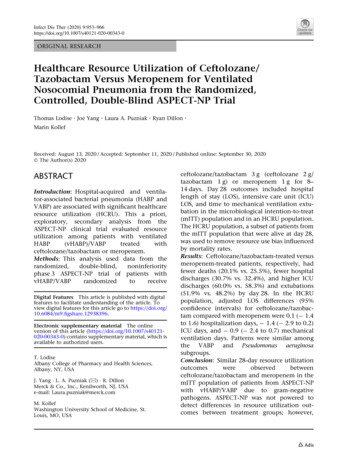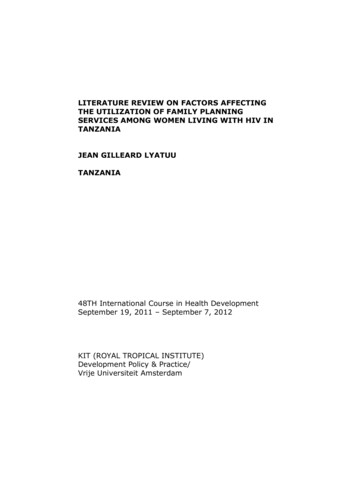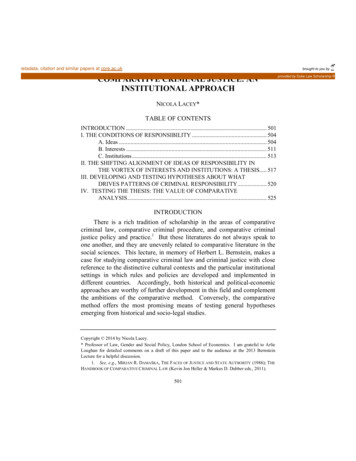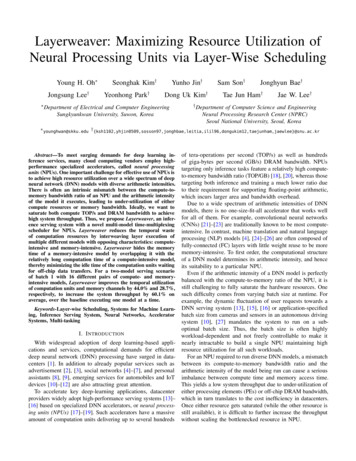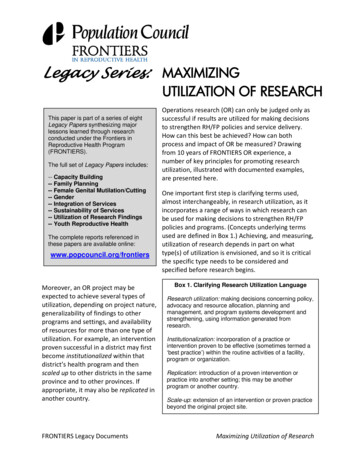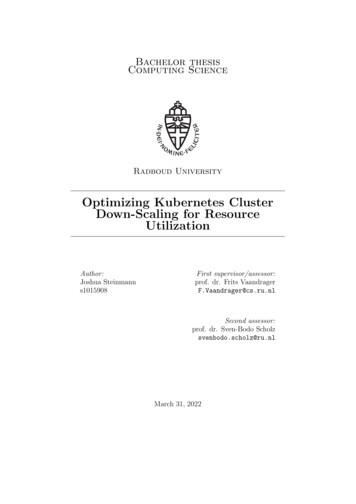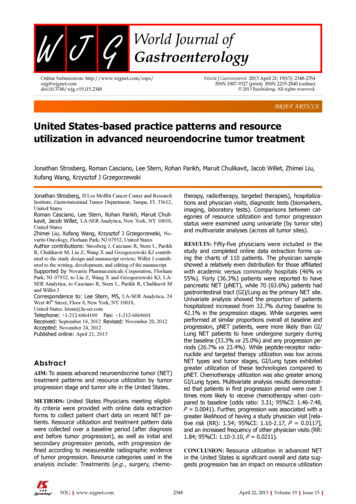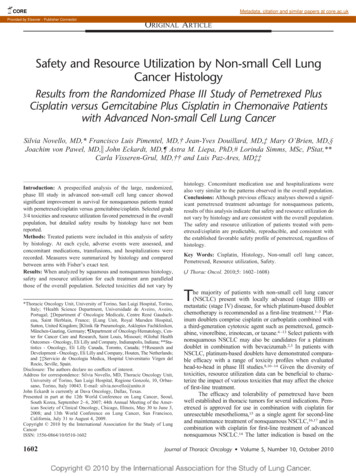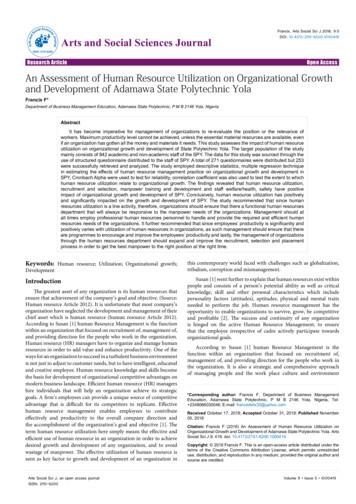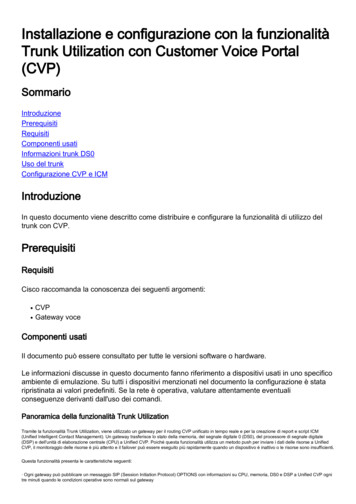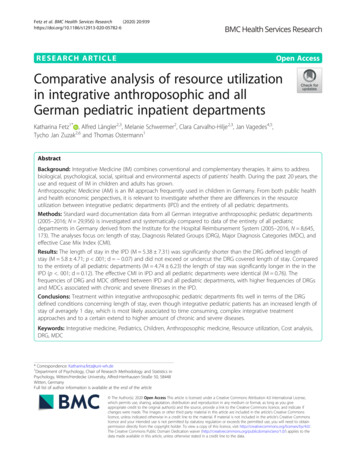
Transcription
Fetz et al. BMC Health Services Research(2020) SEARCH ARTICLEOpen AccessComparative analysis of resource utilizationin integrative anthroposophic and allGerman pediatric inpatient departmentsKatharina Fetz1* , Alfred Längler2,3, Melanie Schwermer2, Clara Carvalho-Hilje2,3, Jan Vagedes4,5,Tycho Jan Zuzak2,6 and Thomas Ostermann1AbstractBackground: Integrative Medicine (IM) combines conventional and complementary therapies. It aims to addressbiological, psychological, social, spiritual and environmental aspects of patients’ health. During the past 20 years, theuse and request of IM in children and adults has grown.Anthroposophic Medicine (AM) is an IM approach frequently used in children in Germany. From both public healthand health economic perspectives, it is relevant to investigate whether there are differences in the resourceutilization between integrative pediatric departments (IPD) and the entirety of all pediatric departments.Methods: Standard ward documentation data from all German integrative anthroposophic pediatric departments(2005–2016; N 29,956) is investigated and systematically compared to data of the entirety of all pediatricdepartments in Germany derived from the Institute for the Hospital Reimbursement System (2005–2016, N 8,645,173). The analyses focus on: length of stay, Diagnosis Related Groups (DRG), Major Diagnosis Categories (MDC), andeffective Case Mix Index (CMI).Results: The length of stay in the IPD (M 5.38 7.31) was significantly shorter than the DRG defined length ofstay (M 5.8 4.71; p .001; d 0.07) and did not exceed or undercut the DRG covered length of stay. Comparedto the entirety of all pediatric departments (M 4.74 6.23) the length of stay was significantly longer in the in theIPD (p . 001; d 0.12). The effective CMI in IPD and all pediatric departments were identical (M 0.76). Thefrequencies of DRG and MDC differed between IPD and all pediatric departments, with higher frequencies of DRGsand MDCs associated with chronic and severe illnesses in the IPD.Conclusions: Treatment within integrative anthroposophic pediatric departments fits well in terms of the DRGdefined conditions concerning length of stay, even though integrative pediatric patients has an increased length ofstay of averagely 1 day, which is most likely associated to time consuming, complex integrative treatmentapproaches and to a certain extend to higher amount of chronic and severe diseases.Keywords: Integrative medicine, Pediatrics, Children, Anthroposophic medicine, Resource utilization, Cost analysis,DRG, MDC* Correspondence: Katharina.fetz@uni-wh.de1Department of Psychology, Chair of Research Methodology and Statistics inPsychology, Witten/Herdecke University, Alfred-Herrhausen-Straße 50, 58448Witten, GermanyFull list of author information is available at the end of the article The Author(s). 2020 Open Access This article is licensed under a Creative Commons Attribution 4.0 International License,which permits use, sharing, adaptation, distribution and reproduction in any medium or format, as long as you giveappropriate credit to the original author(s) and the source, provide a link to the Creative Commons licence, and indicate ifchanges were made. The images or other third party material in this article are included in the article's Creative Commonslicence, unless indicated otherwise in a credit line to the material. If material is not included in the article's Creative Commonslicence and your intended use is not permitted by statutory regulation or exceeds the permitted use, you will need to obtainpermission directly from the copyright holder. To view a copy of this licence, visit http://creativecommons.org/licenses/by/4.0/.The Creative Commons Public Domain Dedication waiver ) applies to thedata made available in this article, unless otherwise stated in a credit line to the data.
Fetz et al. BMC Health Services Research(2020) 20:939BackgroundIntegrative Medicine (IM) is “healing-oriented medicinethat takes account of the whole person, including all aspects of lifestyle. It emphasizes the therapeutic relationship between practitioner and patient, is informed byevidence, and makes use of all appropriate therapies” [1].It considers biological, psychological, social, spiritual,and environmental aspects of health [2]. It is not “a discipline, a group of disorders, or a method of treatment,but an approach, a way of thinking”, it “encourages clinicians and researchers to consider more than one systemat a time” and “provides a framework for understandingcomplex and dynamic challenges” of the human organism [3]. IM is practiced worldwide and varies in its special approaches depending on cultural and nationalfactors [4]. Therefore, IM is of particular interest fromboth, a public health and health economic perspective.During the last 20 years, the implementation of integrative approaches for children has grown [2, 5–15] worldwide: IM is used in pediatrics in the USA [9, 11, 16–19],in Canada [20] and in Europe [5, 8, 21–25] in private practices, outpatient- and inpatient-departments [23]. Currentliterature suggests that 30–50% of parents of children withacute or chronic diseases use IM for their children [26–29], while it seems to be used more frequently for childrenwith chronic diseases in the US [16, 30–35]. IM’s use forchildren is associated with disease severity and whetherparents use IM themselves [7, 36]. IM is established inacademic pediatrics and is acknowledged as an importantsubspecialty to address children’s needs [2].An IM approach with particular relevance in Europeand Germany is Anthroposophic Medicine (AM). It is amultimodal treatment system founded by Rudolf Steinerand Ita Wegmann in the early 1920s [37] and includescomplementary pharmacotherapy, medicinal baths, rhythmical massages, compresses, and embrocation (rhythmicmassages with etheric oils [38]), as well as art therapy,eurythmy, speech therapies, music therapy [39], and light/color therapy. Consensus-based guidelines for the anthroposophic therapies for children suffering from generalpediatric diseases, such as acute gastroenteritis [40] andbronchitis [41] have already been published.In Europe, AM is integrated into conventional medicalservices and practiced in inpatient and outpatient settings. There are two anthroposophic hospitals inGermany that offer integrative treatment for children indistinct pediatric departments: The Gemeinschaftskrankenhaus Herdecke (community hospital) near Dortmundand the Filderklinik in Filderstadt near Stuttgart [23, 42].A recent study of our working group found a largecatchment area for these hospitals all over Germany andthat parents are willing to travel further distance to getspecialized integrative anthroposophic medical care forchildren with severe and chronic diseases [43].Page 2 of 10However, little is known about the impact of integrative anthroposophic pediatric treatment on resource utilization as one element of economicanalysis. Considering the growing costs of health care,a better understanding of resource utilization is indispensable to provide clinically effective and financiallyresponsible treatment. Especially within the integrativefield, there is a need for research evaluating the resource utilization and benefits for patients and thehealth care system [41, 42]. The evaluation of resource utilization parameters thus may provide valuable information that can be considered when seekingto optimize integrative strategies in order to lowerhealth care costs and to license and scope health careinvestment decisions [44].Until today there is a need of data concerning such resource utilization parameters within integrative pediatrics[45, 46]. Diagnoses-Related Groups (DRG), as well aslength of stay are frequently used to inform health economic and resource utilization analyses in Germany, otherEuropean countries and worldwide [47–50]. Resourceutilization analysis based on such data has rarely beenused within integrative inpatient care [51, 52].Therefore, the aim of the present study is to investigate parameters associated with resource utilizationwithin integrative anthroposophic pediatric departmentsin Germany and to compare them systematically to representative data from all pediatric departments inGermany. Our hypotheses were that:123There is no difference considering the length of staybetween integrative anthroposophic pediatricinpatient departments and a) the entirety of allpediatric departments in Germany, b) the DRGdefined mean length of stay, as well the upper andlower limits.Resource utilization indices, such as the effectiveCase Mix Index of integrative anthroposophicpediatric inpatient departments are comparable tothe entirety of all pediatric departments inGermany.There is no difference in the frequencies of DRG/MDC between integrative anthroposophic pediatricdepartments and all pediatric departments inGermany.MethodsStudy designThe current study is a post hoc observational study.It was conducted according to the Declaration ofHelsinki [53]. It is reported according to theSTROBE guidelines for reporting observational cohort studies [54].
Fetz et al. BMC Health Services Research(2020) 20:939SettingIn Germany, there are two integrative hospitals focusingon Anthroposophic Medicine with pediatric inpatientdepartments: The Gemeinschaftskrankenhaus Herdecke(GKH) near Dortmund and the Filderklinik in Filderstadt near Stuttgart. Both hospitals treat children withvarious diseases reaching from general pediatrics to specialized fields by means of an integrative approach. Thisapproach combines conventional and complementaryremedies.The pediatric department of the Filderklinik on average treats 1245 patients per year. Beneath generalpediatrics, the Filderklinik specifies in neurology, psychosomatic disorders, neonatology, endocrinology, pulmonology and cardiology for children. In the pediatricward of the GKH, 1750 patients are treated on averageevery year. The GKH practices diabetology, oncology,neonatology, rheumatology, psychosomatics and neurology in children alongside general pediatrics. The staffinclude physicians, nursing staff, pharmacists and therapists who are all trained in integrative medicine [43].Diagnosis and treatment in both hospitals are in accordance with official pediatric guidelines from scientificsocieties and furthermore include treatment optionsfrom Anthroposophic Medicine [40, 55]. This anthroposophic treatment includes [43]: complementary pharmacotherapy, medicinal baths, rhythmical massages,compresses, and embrocation (rhythmic massages withetheric oils [38]), as well as art therapy, eurythmy,speech therapies, music therapy [39], and light/ colortherapy [56]. Both hospitals are part of the Germanregular medical care and thus funded by the statutoryhealth insurers.Page 3 of 10[57]. In the data of the entirety of pediatric departments,outlier analysis was not possible since we were not ableto gather raw data from the German consensus bureau.Consequently, exclusion of outliers was not possible.SampleThe integrative anthroposophic sample consists of 29,956 patient cases (Gemeinschaftskrankenhaus: n 17,503 (58.4%); Filderklinik: n 12,453 (41.6%). The sampleof all pediatric departments in Germany includes 48,670,077 patient cases.Resource utilization parametersIn Germany, it is mandatory by law for all hospitals toprovide data concerning health resource utilization tothe Institute for the Hospital Renumeration System(InEK) and the National Consensus Bureau. These resource utilization parameters include Diagnosis RelatedGroups (DRG), Major Diagnosis Categories (MDC), andeffective Case Mix Index (CMI). Therefore, these parameters are considered for comparisons between the integrative anthroposophic and all pediatric departments.Diagnosis related groups and major diagnosis categoriesDRGs are assigned based on patients’ ICD-diagnosis, aswell as procedures, age, sex, discharge status, and thepresence of complications or comorbidities. In 2003 theG-DRG system was established in Germany [58] as anadaption of the Australian DRG system. It is updated annually by the Institute for the Hospital RemunerationSystem (InEK).Data collectionPatient data over the last decade (2005–2016) was derived from the standard ward documentation interfaceAgfa-ORBIS in all integrative anthroposophic pediatricdepartments. The Microsoft Excel -output was importedinto SPSS 24 (Statistical Package for the Social Sciences,IBM), cleaned and a plausibility check was performed.Furthermore, representative data was derived from theGerman National Consensus bureau for all pediatric departments in Germany (2005–2016).Eligibility criteriaThere were no specific criteria of eligibility in the integrative anthroposophic sample. All patient cases of allintegrative anthroposophic pediatric departments inGermany treated between 2005 and 2016 were includedin the integrative sample. Outliers were excluded fromanalysis post hoc. An outlier is an observed value whichdeviates so much from the other values as to arouse suspicions that it was generated by a different mechanismLength of stayThe length of stay is measured in days in both samples.In the German DRG System only full days of stay are included for the length of stay [59]. Besides the length ofstay, the German DRG system provides a mean length ofstay, a minimum-, and a maximum length of stay foreach diagnosis in the DRG-catalogue [59]. The length ofstay of a patient can affect the revenue of a DRG. If thelength of stay is shorter than the DRG defined lowerlimit, a deduction of the revenue is performed [60]. Viceversa, if the length of stay is longer than the upper limit,an additional fee is drawn [61]. For each DRG within theintegrative anthroposophic sample the mean length ofstay, as well as upper and lower limit for length of stay,were calculated using SPSS’ Syntax function.The data source was the DRG case-based lump sumcatalogues for the years 2005–2016 derived from thehomepage of the Institute for the Hospital RemunerationSystem [62].
Fetz et al. BMC Health Services Research(2020) 20:939Page 4 of 10Effective case mix indexIn the German DRG-System (G-DRG), the cost weightsare used to quantify a hospital’s average costs per case inrelation to the specific resource utilization. This includesthe Case-Mix (CM), which is equal to the sum of thecost weights of all DRGs performed over a given timeperiod. The average case weight, which is called CaseMix index (CMI), is calculated by dividing the CM bythe total number of cases. Consequently, the CMI isequal to the average DRG cost weights for a particularhospital. The CMI is suitable for the comparison of theutilization of health care resources in different hospitals[63].The effective CMI considers the deductions in the caseof patient transfer or short-stay outliers, and surchargesfor long-stay outliers and thus reflects the effort of acare provider for the treatment of a patient. An effectiveCMI value greater than 1.0 reflects a more extensivecase compared to the average, while a value less than 1.0indicates a less extensive case. In this way, the effectiveCMI maps the actual calculated amount for case fees[64]. Hence, in our study, the effective CMI of both samples were used for comparison of resource utilization between integrative anthroposophic and all Germanpediatric departments.Statistical analysisAll statistical analyses are performed using IBM SPSSVersion 24 and R Statistics. Mean differences betweenthe integrative anthroposophic sample and all pediatricdepartments are tested for statistical significance bymeans of t-tests for independent samples. Because of cumulative testing the level of statistical significance wasBonferroni adjusted to p .01. Due to the high sample-size, Cohen’s d is calculated as a standardized measureof effect independent of the sample size.ResultsLength of stayThe mean length of stay in the integrative anthroposophic sample was 5.38 days (SD 7.31, n 29,956). Figure 1 illustrate the length of stay in the integrativesample compared to the DRG defined upper and lowerlimit of length of stay. The length of stay in the integrative anthroposophic sample did not exceed or undercutthe DRG defined upper and lower limits for length ofstay.Overall, the mean length of stay in the entirety of allpediatric departments was 4.48 days (SD 7.83; n 38,724,087). A t-test for independent samples showed a significant mean difference between the integrative anthroposophic and all pediatric departments (t (38,754,041) 49.41 p .01; Cohen’s d 0.12). The average length ofstay per year in the integrative anthroposophic and in allpediatric departments is shown in Table 1. The length ofstay in the integrative anthroposophic sample was significantly lower (M 4.74; SD 6.23) than the meanlength of stay defined by DRG (M 5.8; SD 4.71; t (28,236) 37.74; p .01; Cohen’s d 0.07). The meanlength of stay in the integrative anthroposophic and allpediatric departments compared to the mean length ofstay proposed by DRG are shown in Fig. 2.Effective case mix indexThe average effective CMI in the integrative anthroposophic sample is 0.76 (SD 1.22; n 29,956).Overall the average effective CMI in the entirety of allpediatric departments was 0.76 (SD 1.97; n 200720082009201020112012201320142015yearDRG lower limit for length of staylength of stay in the integrative sampleDRG upper limit for length of stayFig. 1 Mean length of stay in the integrative anthroposophic pediatric departments in comparison to upper and lower DRG definedlength of stay limits
Fetz et al. BMC Health Services Research(2020) 20:939Page 5 of 10Table 1 Mean length of stay, CMI and Effective CMI per year in the integrative anthroposophic sample and in the conventionalsampleMean length of stayEffective Case Mix IndexyearIntegrative departmentsMean (SD, n)Entirety of all pediatricdepartments Mean (SD, n)Integrative departmentsMean (SD, n)Entirety of all pediatricdepartments Mean (SD, n)20065.56 (7.22; 2752)4.97 (8.10; 841,100)0.73 (1.10; 2826)n.a.20075.76 (6.96; 2792)4.82 (7.88; 854,341)0.71 (0.83; 2876)n.a.20085.33 (6.67; 2819)4.65 (7.63; 859,058)0.72 (1.18; 2903)n.a.20095.44 (7.20; 2841)4.55 (7.84; 860,384)0.80 (1.64; 2908)n.a.20105.57 (7.47; 2790)4.55 (7.90; 860,961)0.78 (1.33; 2859)0.77 (1.99; 853,146)20115.36 (7.23;2947)4.39 (7.75; 866,611)0.77 (1.32; 2992)0.76 (1.98; 858,813)20125.28 (7.53; 2947)4.30 (7.55; 866,809)0.74 (1.19; 3021)0.75 (1.91; 858,809)20135.23 (7.69; 3068)4.24 (8.41; 879,100)0.75 (1.21; 3138)0.75 (2.00; 871,377)20145.07 (7.01; 3228)4.18 (7.67; 877,896)0.77 (1.14; 3317)0.76 (1.94; 870,090)20155.27 (7.92; 3039)4.16 (7.61; 878,913)0.78 (1.17; 3116)0.76 (1.99; 870,569)overall5.39 (7.29; 29,203)4.48 (7.834; 8,645,173)0.75 (1.23; 29,956)0.76 (1.97; 5,182,804)515). The average effective CMI in the integrative andall German pediatric departments per year is shown inTable 1.Diagnoses related groupsThe most frequent DRG in the integrative anthroposophic sample were B80Z (head injuries; n 1933, 6.5%),G67B (esophagitis, gastroenteritis, gastrointestinal bleeding, ulcer, complex genesis; n 1286, 4.3%), P67C (newborn 2499 g, without complex diagnosis; n 1254,4.2%), G67C (esophagitis, gastroenteritis, gastrointestinalbleeding, ulcer, uncomplex genesis; n 1158, 3.9%) andP67B (n 975, 3.3%, newborn 2499 g, with complexdiagnosis).In the entirety of all pediatric departments, the mostfrequent DRG’s were G67B (esophagitis, gastroenteritis,gastrointestinal bleeding, ulcer, complex genesis; n 561,552; 8.78%) G67C (esophagitis, gastroenteritis, gastrointestinal bleeding, ulcer, uncomplex genesis; n 440,529;6.89%); B80Z (head injuries; n 382,762; 5.99%) andD63Z (otitis media or infections of the upper respiratorytract, age 3 years; n 310,283; 4.85%). The 50 most frequent DRG in both groups per year and overall areshown in the supplemental materials 1 and 2.Major diagnosis categoriesThe most frequent MDC in the integrative sample wereDiseases and Disorders of the Nervous System (n 015yearconventional sample: mean length of stayintegrative sample: mean length of stayDRG defined mean length of stayFig. 2 Mean length of stay in the integrative departments and all German pediatric departments compared to the DRG defined mean lengthof stay
Fetz et al. BMC Health Services Research(2020) 20:93917.90%), Diseases and Disorders of the Respiratory System (n 4155, 13.87%), Newborn and other NeonatesPerinatal Period (n 4068; 13.58%) and Diseases andDisorders of the Digestive System (n 4007; 13.38%). Inthe entirety of all pediatric departments in Germanysample the most frequent MDC were Diseases and Disorders of the Digestive System (n 1,502,678; 23.50%);Diseases and Disorders of the Respiratory System (n 1,066,127; 16.67%); Diseases and Disorders of the NervousSystem (n 876,894; 13.71%); Diseases and Disorders ofthe Ear, Nose, Mouth and Throat (n 671,922; 10.51%).The percentages of the MDC compared in both samplesare presented in Fig. 3.There were some significant differences in the frequencies of the MDCs between the integrative pediatric departments and all German pediatric departments. Higherfrequencies in the integrative sample were observed forthe MDC: Newborn and other Neonates Perinatal Period(IPD: 13.88% vs. 0.87%); Alcohol, Drug Use, Induced Mental Disorders (IPD: 8.57 vs. 3.32%); Mental Diseases andDisorders (IPD: 4.27% vs. 1.16%); Diseases and Disordersof the Endocrine, Nutritional and Metabolic System (IPD:7.43 vs 2.74); Diseases and Disorders of the Nervous System(IPD: 17.90% vs 13.71%).Lower frequencies in the integrative sample were observed for the MDCs:Page 6 of 10Pregnancy, Childbirth and Puerperium (IPD: 0.0% vs9.6%); Diseases and Disorders of the Digestive System (IPD:13.87% vs 23.05%); Diseases and Disorders of Ear, Nose,Mouth and Throat (IPD: 4.69% vs. 10.51%); Diseases andDisorders of the Respiratory System (IPD: 13.87% vs. 16.67%).DiscussionIn this study, we aimed to investigate resource utilizationparameters of integrative anthroposophic pediatric departments and to compare them to corresponding datafrom all pediatric departments in Germany. In accordance with our initial hypothesis, we found no differencebetween pediatric integrative anthroposophic departments and the entirety of all pediatric departments concerning effective Case Mix Index. The length of stay inthe integrative departments was shorter than the meanDRG-defined mean length of stay and within upper andlower limits, which was in line with our hypothesis.Furthermore, we hypothesized that these department donot differ from the entirety considering patients’ length ofstay. Contrary to this hypothesis, we found that the meanlength of stay was significantly longer in the integrativeanthroposophic departments compared to all Germanpediatric departments. Another hypothesis was that the departments do not differ considering the frequency distribution of DRG and MDC. Our data did not support thisFig. 3 Percentages of MDCs in integrative anthroposophic departments and in the enterity of all German pediatric departments
Fetz et al. BMC Health Services Research(2020) 20:939hypothesis, but much more implied some systematic discrepancies between the integrative anthroposophic pediatric departments and all German pediatric departments.Length of stayThe average length of stay in the integrative sample wassignificantly lower than the mean length of stay definedby DRG. It did furthermore, not exceed the upper limitof length of stay defined by DRG or undercut the lowerlimit of length of stay defined by DRG. This result implies that integrative pediatric departments in Germanycan provide care within the terms of the DRG definedconditions concerning length of stay. In contrast to previous studies, we found no indication for less resourceutilization in the integrative departments [65, 66].The mean length of stay in the integrative anthroposophic departments was significantly longer compared tothe mean stay in all German pediatric departments. Thisfinding is in line with previous research that found longer length of stay in integrative anthroposophic [51] andintegrative naturopathic departments [45]. This circumstance may most likely be due to the large number oftime-consuming diagnostic and medical procedures thatare associated with integrative anthroposophic treatment. Previous studies found an association of increasedlength of stay in integrative medical department with theutilization of additional anthroposophic [51] or naturopathic [45] reimbursement, which requires a longer stay.Considering this, the relative difference of 1 day in thelength of stay between the departments is comparativelylow. While this difference is statistically significant, theeffect size is low. However, in this context, it needs to bestated that outliers with extreme lengths of stay (mainlyfrom the diagnosis spectrum of eating disorders) wereexcluded prior to analysis.Effective case mix indexThe mean effective CMI were identical in the integrativesample and in all German pediatric departments. Thisfinding indicates that integrative pediatric departmentshave comparable resource utilization management togeneral pediatric departments, which is in line withcomparable cost analyses [45].Diagnosis related groups and major diagnosis categoriesIn both samples, esophagitis, gastroenteritis, gastrointestinalbleeding, ulcer (G67B; G67C) and head injuries (B80Z)belonged to the most frequent DRG’s. The percentages varied between the integrative anthroposophic and all pediatricdepartments. While newborn 2499 g, without complex diagnosis was one of the most frequent DRG’s in the integrativeanthroposophic sample, otitis media or infections of theupper respiratory tract age 3 years (D63Z) was more frequent in the entirety of all German pediatric departments.Page 7 of 10The frequencies of the MDCs in the integrativeanthroposophic sample showed some significant differences in comparison to the entirety of all pediatric departments in Germany. Higher frequencies could beobtained for MDCs of chronic diagnosis spectrum, suchas mental, endocrine, and nervous disorders. Lower frequencies were found for acute diseases, such as digestive,respiratory, and ENT- disorders. A similar pattern wasobtained in the DRG frequencies.This result pattern is known from a previous study ofour working group on the patient characteristics and clinical characteristics of integrative anthroposophic pediatricdepartments in Germany [43]. Furthermore, this result isin line with other international studies that conclude thatthe use of integrative medicine seems to be more frequentin in children with severe and chronic diseases [7, 16, 30–36]. The higher frequency of chronic and severe diseasesmay be another factor influencing the longer length of stayin the integrative pediatric departments.The large difference considering the MDC newborns,neonates and diseases of the perinatal period, is mostlikely due to the specification of the GKH with its centerfor neonatology. The absence of pregnancy, childbirth,and puerperium in the integrative anthroposophic samplemay be explained by the circumstance that the treatmentin this MDC is merely used by the gynecologic department in the integrative anthroposophic hospitals but notby the pediatric department. The higher percentage of thisMDC in all German pediatric departments may be causedby teenage pregnancies or mothers who are treated in thepediatric department because their neonate child istreated in the pediatric department.Strengths and limitationsThe aim of the present study was to contribute to the better understanding of resource utilization, as measured bylength of stay, in pediatric integrative medicine inGermany. A big strength of this study is that it is the firstsystematic investigation of a large sample of integrativepediatric resource utilization data with comparison to representative data of the entirety of all pediatric inpatient departments in Germany. One major limitation of this studyis that it is a secondary data analysis. We were not able togain raw data from the German Federal Statistical Officefor the entirety of pediatric hospitals in Germany. Consequently, it was not possible to exclude any outliers in thissample. Future analyses also need to look at the impact onresource utilization in primary and outpatient care, as wellas rehabilitation and social care where appropriate as theymay influence the length of stay of in-patients.We also recognize that this analysis only provides oneaspect of information required for future economicevaluation; sequential services and the use of resourcesfor the entire episode of care were not addressed in this
Fetz et al. BMC Health Services Research(2020) 20:939study. To do so, data on resource use and their costs between integrated pediatric hospitals and other pediatrichospitals will need to be combined with comparativedata on outcomes associated with treatment in these settings. This would include analysis for different population sub-groups, for instance by different MDC. Ideallyoutcomes would be measured in terms of impact onquality of life so that the health economic gold standardof incremental cost per quality adjusted life year (QALY)gained could then be assessed. It would also be important to look at whether there are differences in patternsof rehospitalization as part of any future economicevaluation.ConclusionsThe comparison of resource utilization in integrativeanthroposophic pediatric departments to the entirety ofpediatric departments in Germany shows a heterogeneous pattern of similarities and differences. The effective Case Mix Indices were identical, indicati
source utilization parameters within integrative pediatrics [45, 46]. Diagnoses-Related Groups (DRG), as well as length of stay are frequently used to inform health eco-nomic and resource utilization analyses in Germany, other European countries and worldwide [47-50]. Resource utilization analysis based on such data has rarely been
